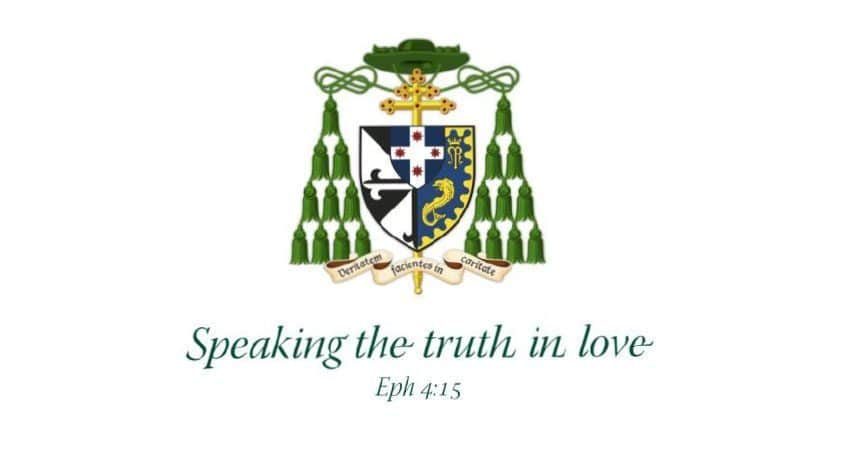HOMILY FOR THE CHRISM MASS

St Mary’s Cathedral, Sydney, Maundy Thursday, 6 April 2023
We know what the proverb means, but not where it comes from. “The eyes are the window to the soul” has been attributed to Sophia Loren,[1] Charlotte Brontë,[2] Ben Jonson,[3] Shakespeare,[4] da Vinci,[5] Cicero[6] and the Bible[7], though none of them actually said it. The thought is that you can read on someone’s face and eyes what’s going on underneath and who they really are. Eyes are more than receptacles for light; they also give back.
Literature is full of optical allusions. In Jane Eyre Rochester loses his sight in a fire, and Jane must become his eyes. But Brontë observes that eyes are “the interpreter of the soul”, and Jane is first drawn by Rochester’s brilliant black eyes that tell of his inner power. As Dante ascends through the heavens in his Paradiso, he sees God Himself reflected in the eyes of his beloved Beatrice.[8] And In Search of Lost Time, Marcel Proust suggested that “The real voyage of discovery consists, not in seeking new landscapes, but in having new eyes.” [9]
Michelangelo, God separating the Light from the Darkness and Temptation of Adam and Eve (1512), Sistine Chapel
The Bible has plenty of ‘opto-theology.’ Creation begins with light and with each new creation God saw it was good (Gen ch. 1). Human beings are given sight so they too can appreciate creation, classify and steward it.[10] More crucially, we are told they are created in the image of God (Gen 1:26-27)—a strange teaching, given the Old Testament’s insistence that no-one has ever seen God and that all images of God are idolatrous.[11] If our likeness is to God’s intelligence, freedom and love, our appearance was nothing like His—until He became one of us, that is. But there were intimations of his incarnation in the Garden of Eden, when God walked in the garden as will Jesus at the Resurrection (Gen 2:8-9; 3:8; Jn 20:14-15). The Serpent tempts the Woman with desirable fruit and a promise that by tasting it her “eyes would be opened”, so her husband and she would be godlike, determining good and evil (Gen 3:5-6). Instead, of course, their eyes were opened to their shame and the consequences of their sin (Gen 3:7-19,23-24)—the worst of which was losing sight of the Divine Gardener. But He continued to love and bless them with food, clothing, children.
As the story of salvation continues, a covenant is established with Abraham who is told to “lift up his eyes” to see the heavens where there is a star for everyone of his descendants, and then to look down upon the land promised them (Gen 13:14-17). Moses, too, who had averted his eyes from looking directly upon God (Ex 3:6; 33:20), still had undimmed eyes at age 120, when he too glimpsed the promised land (Dt 34:1-7). At times God heals blindness, as in the stories of Tobit (Tob 2:7-10; 5:10; 11:7-18) and of Paul (Acts ch. 9). God lets Israel see many wonders.[12] But what really matters is insight and the Prophets critique surface-sight, calling the People to open their eyes to what God was doing.[13] The Wisdom literature is also peppered with references to sight: clear, well-focused, insightful eyes are praised; deceiving, distracted, greedy or haughty eyes condemned.[14] Eyes are for seeing clearly, but also deeply; spiritual sight is more important that physical.
Holman Hunt, The Light of the World (1854), Keble College Oxford
Jesus’ story had its fair share of optical references too. He comes as Light into a dark world, enlightening hearts and minds.[15] In our Gospel this morning “all eyes in the synagogue were fixed on him” as He began to preach (Lk 4:16-21). He declares that He has been anointed to evangelise, liberate, favour—and bring new sight. As if rehearsing for Holy Week, the crowd delight in His gracious words and sing His praises; yet only a few verses later, they turn on Him and try to kill Him (Lk 4:22,28-30).
After this morning’s mission statement, Jesus prosecuted His mission of preaching and healing, opening the eyes of the blind.[16] In the Sermon on the Mount, He told His disciples to be light to the world for all to see; to use their sight well, not lustfully; to rid themselves of sinful eyes, rather than be led by them to damnation; to remove impediments to their vision before judging others.[17] After that He taught much else about what it is to perceive well, and graced many with the spiritual perception to see who He really was.[18]
Holy Week challenges both our physical and spiritual sight. A week before, we witnessed the raising of Lazarus, and saw tears streaming from Jesus’ eyes and those of the sisters and friends (Jn 11:1-44). Jesus wept in grief, sympathy and in indignation at evil. But they became tears of joy when He raised His friend from the dead. A week later He entered Jerusalem with an excited crowd waving branches and singing Hosannas (Mt 21:1-11). But seeing the city, He wept again, this time at the faithlessness of the inhabitants and the destruction to come (Lk 19:41-44; cf. Mt 23:37-24:2).
No doubt there were more tears during His agony, scourging and crucifixion. Tomorrow we will read from the Letter to the Hebrews that “During his life on earth, Jesus prayed aloud and in silent tears, to the One who could save him from death and his prayers were answered” (Heb 5:7). Peter, too, wept bitter tears after betraying his Lord (Mt 26:75) and the women wail as they see Him taken to His death (Lk 23:27-28). In the Stabat Mater we recall that “at the cross her station keeping, stood the mournful mother weeping”. This week tears tell what we see and feel.

The leaders and mob also have vision issues, not due to soft-heartedness so much as hard. Jesus warns that “the eye is the lamp of the body” and can betray an inner darkness as much as inner light (Mt 6:22; Lk 11:34-36). None are so blind as those who refuse to see,[19] fixated as they are on externals, on their preconceptions, on their own power and security. They were blind to the action of God around them. There was Truth, standing right in front of them and they asked “What’s truth?” (Jn 18:37-38; 19:5)
Eyes feature throughout Holy Week. Tonight the disciples will see the Lord wash feet and institute the Eucharist. They wink at each other as messages are passed around the table. In the Garden their eyes are so heavy with exhaustion—and grog—that they fail to watch with Him even a little time (Mt 26:36-46). False witnesses testify at His trial, lying about what they have seen. Caiaphas and Pilate turn a blind eye to the injustice. Jesus is mocked, tortured, stripped, and crucified for all to see. Darkness descends as the Light of the World is snuffed out, and stranger sights follow (Mt 27:45,51-53). When those on watch see these things, they say “Truly, this was the Son of God!” (Mt 27:54)
My brother priests, to this day, splinters of sin and cataracts of vice prevent us from seeing God properly. Pride and ego blur our vision and cause us to stumble. But the cosmic optometrist wants to give us sight and insight, new lenses by which to see clearly.
You are the ministers of that light and healing, and the privileged means are our rituals, including those with the oils we consecrate today. Proust suggested that the artist’s contribution is not so much his works as his ability to help others see things afresh; so too, dare I say, with priests. Anointing them with the oil of gladness, you give your people hope, beyond the terrible sights of the two days ahead or the trials in their own lives. May the People of God be brought by you to see the Risen Christ in the world around them, as His first tearful followers encountered Him resurrected in the Garden and by the Sea (Mt 28:9-10,16-20; Mk 16:9; Lk 24:34; Jn 20:11-21:1-23). May they glimpse with your help the glory of the Risen One in the privacy of their homes, as our first brothers and sisters did in the Cenacle (Mk 16:14-18; Lk 24:36-39; Jn 20:19-29). And may they recognise Him in the Breaking of the Bread in your anointed hands, as did the disciples in Emmaus at Easter (Mk 16:12; Lk 24:16,30-31).
Word of Thanks after Communion, Chrism Mass, St Mary’s Cathedral, Sydney, 6 March 2023

My thanks to our bishops and priests who renewed their priestly vows today and daily renew that commitment by their service to God and His people. The oils we consecrated today also highlight the daily work of our priests and, on behalf of the Bishops and People of Sydney, I thank them for that service. I thank as well our MC, deacons, seminarians, servers and choir.
Next month will be celebrated the Coronation of our King. At the core of the liturgy, in some ways as important as the crowning itself, he will be anointed with the sacred chrism. It will be an Anglican-Greek orthodox version, but the same idea. Every time our priests crown a baby at baptism with the sacred chrism, or an older person at Easter, or when they share with the bishop in confirming someone, they are highlighting that the People of God are a royal, priestly and prophetic people by virtue of their Baptism. I am grateful, therefore, to God’s royal people in Sydney who join with their priests in celebrating these holiest feasts over the Sacred Triduum, but also in celebrating the sacraments all year round. May God bless you fathers and your people in the holy days ahead.
[1] https://www.brainyquote.com/quotes/sophia_loren_163986 and others give no source for but attribute to Sophia Loren: “Beauty is how you feel inside and it reflects in your eyes.”
[2] The closest I can find in Charlotte Bronte is Jane Eyre (1847), ch. XXVII: “The soul, fortunately, has an interpreter—often an unconscious, but still a truthful interpreter—in the eye.”
[3] The closest I can find in Ben Jonson is the poem To Celia (1616): “Drink to me only with thine eyes”.
[4] E.g. https://www.innovgas.com/news/the-eyes-are-the-window-to-your-soul. The closest I can find in William Shakespeare (1564-1616) is not very close, referring as it does to the dreaming closed eye: in Sonnet 43 (1609) https://shakespeares-sonnets.com/sonnet/43: “When most I wink, then do mine eyes best see, / For all the day they view things unrespected; / But when I sleep, in dreams they look on thee, / And darkly bright, are bright in dark directed.”
[5] E.g. https://quotefancy.com/quote/853045/ and others give no source but attribute to Leonardo da Vinci (1452-1519): “The eye, the window of the soul, is the chief means whereby the understanding can most fully and abundantly appreciate the infinite works of Nature; and the ear is second.”
[6] The closest quote I can find attributed to Cicero is “Ut imago est animi voltus sic indices oculi—The face is a picture of the mind, as the eyes are its interpreter.”
[7] The closest I can find in Jesus is Mt 6:22-23: “The eye is the lamp of the body. So, if your eye is healthy, your whole body will be full of light; but if your eye is sick, your whole body will be full of darkness. If, then, the light in you is dark, how great is the darkness.”
[8] “Following the gaze: Beatrice’s eyes and beauty in The Divine Comedy,” VoegelinView 22 December 2020 https://voegelinview.com/following-the-gaze-beatrices-eyes-and-beauty-in-the-divine-comedy/
[9] Marcel Proust, In Search of Lost Time, vol. 5: The Prisoner and the Fugitive (1923 and 1925, trans. Carol Clark, New York: Penguin, 2003). 237.
[10] Gen 1:26-30; 2:19-20; Ex 4:11; Prov 20:12.
[11] Ex 3:6; 20:3; 33:20-23; Lev 26:1; Ex 20:3-6; Isa 6:5; Jn 1:18; 3:13; 4:24.
[12] 2Kgs 6:17; Ps 146:8; Isa 29:18; 35:5; 42:6-7 etc.
[13] 1Sam 16:7; Ezek 12:2; Isa 6:10; 29:9; 35:5-8; 42:18-19; 43:8; 56:10; Jer 5:21.
[14] e.g. Ps 19:8; 119:37; 121:1; Prov 10:10; 20:12; 21:4; 22:9; 27:20
[15] Mt 2:2,9; 4:16; Lk 1:79; 2:9-20,30-32; Jn 1:4-9; 3:19; 9:5; 12:46; Eph 5:8; 1Pet 2:9.
[16] Mt 9:27-31; 11:5; 12:22; 15:30-31; 20:29-34; 21:14; Mk 8:22-26; 10:46-52; Lk 7:22; 18:35-43; Jn 5:3; 9:1-41; 11:37; cf. Acts 9:18.
[17] The disciples are to be light/lamps, proclaiming and doing good works for all to see: Mt 5:14-16; cf. Lk 11:33; 16:8; Jn 3:21; 11:9; 1Jn 2:11. They were to use their own sight well, not lustfully or hatefully: Mt 5:22,28. They were to rid themselves of sinful eyes, rather than be led by them into sin and damnation: Mt 5:29; cf. Mt 18:9; Mk 9:47. They were to remove impediments to their vision before judging others: Mt 7:3; Lk 6:41.
[18] Lk 24:30-31; Acts 13:11-12; Rom 2:19; Eph 1:18.
[19] Mt 15:14; 15:14; 23:16-26; Lk 6:39; Jn 9:39-41; 12:40.
INTRODUCTION TO THE CHRISM MASS – ST MARY’S CATHEDRAL, SYDNEY, MAUNDY THURSDAY, 6 APRIL 2023
Welcome to this year’s Chrism Mass as we look ahead to the joy and hope of Christ’s Easter glory. Today, as testimony to their communion with Christ, our shepherds will renew their priestly promises. Today, as testament to their communion with their Bishop and each other, they will concelebrate the Holy Eucharist. Today, as witness to their communion with the people they serve, they will consecrate the oils for the sacraments.
I acknowledge auxiliary Bishops Richard Umbers and Danny Meagher, auxiliary bishop emeritus Terry Brady, Monsignor Carl Reid of the Ordinariate of Our Lady of the Southern Cross, Vicar-General Gerry Gleeson and our episcopal vicars, cathedral Dean Don Richardson and our other deans, brother priests, deacons and religious, and our beloved seminarians. I also welcome representatives of our parishes.
We pray for those who could not be with us today due to sickness and frailty. And we pray for the repose of our brother priests who have died since our last Chrism Mass: Cardinal George Pell, Frs Ray Weaver, Kevin O’Grady, Joseph Visentin CS, Barry Brundell MSC, Peter Maher, John de Luca and John Keeble.
We celebrate with gratitude those priests who have achieved major milestones in their ministry: in particular, our diamond jubilarians Frs Vittorio Basso, Terry Bell, Witold Bry/mora, Peter Christie and Tony Doherty; our golden boys Frs James Collins SM, John Evans SSC, Phillip Hicks MSC, Brian Rayner and Phil Zadro; and our silver souls, Frs Joti Bilo/walu CM, Hertanto Dwiwibowow MSC, Martin Monaghan, Thuy Pham SVD, Anthony Robbie, Delmar Silva CS, Patrick Teitiaus MSC, Basil Sousanieh—and any others I’ve missed!
Since our last Chrism Mass, we’ve also been blessed with priestly ordinations of: Bijoy Joseph, Mark Anderson, Ben Gandy, Benjamin Saliba and Adrian Simmons; and the diaconal ordinations of Richard Sofatzis, Matthew Lukaszewicz, Zeljko Evetovic, Ronny D’Cruz and Kenji Konda MSC; and at least sixteen other clergy that I know of who have come to work or retire in our Archdiocese in the past year. We also welcome our seminarians from our two seminaries, including the seventeen newcomers this year to Good Shepherd, looking forward to the day when they will make and renew their priestly vows and join us at the altar. To everyone present, a very warm welcome.

